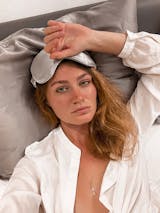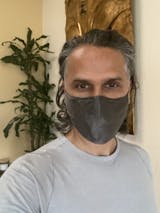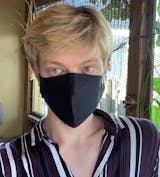Silk is a beautiful, smooth fabric that often denotes luxury and opulence. Originating from ancient China this deluxe fabric was first reserved for Chinese Emperors and silk garments were often used as gifts from Emperors.
In this day and age, the uses of silk have migrated across the world and we find a variety of products from fabrics all the way to medical and beauty products that incorporate silk due to its variety of benefits. But what are the advantages of this mystical fabric originally reserved for Emperors, and is it a sustainable luxury that we can enjoy whilst loving the earth?
In this article, we take a deeper look into the magic of silk and how it can benefit your sustainable wellness journey.
Why Is Silk A Sustainable Fabric?
Silk is a sustainable fabric because it’s a natural biodegradable fabric that requires less water, energy, and chemical input to manufacture. It’s certainly not a sustainable disadvantage-free fabric—but what fabric is?
Wild silk is the most sustainable type of silk, followed by organic silk. Wild silk is far less common as it is not as easy to scale as a business. The silk produced by wildcrafted silk is less uniform in quality, which results in wild silk requiring far more labor in order to spin into quality fabrics.
Organic silk is also much kinder to the environment due to the strict requirements around the use of chemicals such as pesticides, fertilizers, and other chemical agents such as non-biodegradable dyes during manufacture and production. This prevents long-term damage to the land used for silk production and disposal and means that the material is free from harmful chemicals. This helps to ensure that it biodegrades without lasting damage to the earth.
Let’s explore the advantages and disadvantages of the ethical sustainability of silk so you can make your own informed decision based on the pros and cons of silk as a sustainable fabric.
The Advantages Of Silk As A Sustainable And Ethical Fabric
- Natural Fiber.
- Fully Biodegradable (Dependant On Its Post-Processing Treatments).
- Silk Is A Renewable Resource.
- Requires Less Water Than Many Other Fabrics.
- Requires Fewer Chemicals Than Many Other Fabrics.
- Requires Less Energy Than Many Other Fabrics.
- Organic Silk Has A Much Lower Impact On Soil, Community, And Wildlife Health.
The Disadvantages Of Silk As A Sustainable And Ethical Fabric
- Not Suitable For Vegans As Silk Is Made Using Silk Worms Which Are Used In The Process Of Cultivation. Wild Silk Is More Suitable For Vegans.
When evaluating the biodegradability of silk it’s important to source silk from manufacturers that process their silk with sustainability in mind. Fabric dyes, blended fibers, and chemical processing can all affect the ability of silk to biodegrade.
Sustainable silk farmers and producers ensure that the processes required for silk production have a minimal impact on the environment. For example, they will ensure that production water is treated before being released back into the environment if it is contaminated with manufacturing chemicals. And they will choose sustainable and biodegradable dyes and production processes to minimize environmental damage.
Overall, silk is a sustainable fabric that has many environmental benefits in comparison to other fabrics that are non-biodegradable and that require far more chemical and energy processing.
Is Silk A Good Fabric? Is Silk Really Worth The Investment?
Surprisingly, silk isn’t just a luxury. It’s a fabric that has many benefits from aesthetics all the way to medical use. Silk is mainly made up of two proteins called fibroin and sericin. And these proteins have been successfully used in medicine and beauty for their beneficial properties to the skin and hair.
The Journal Of Cosmetic Dermatology reviewed the use of silk sericin within skin cosmetics and found that sericin is an effective moisturizer as it helps to prevent water loss from the skin (1). Another academic study that reviewed the medical use of silk fibroin and silk sericin found that fibroin and sericin hold great wound healing properties by improving collagen deposition and production (2).
A clinical study in 2018, found that silk sericin hydrogel successfully promotes scarless healing in wounds along with the complete healing and recovery of hair follicles and sebaceous glands unlike the majority of other wound dressings (4).
In 2020, the Department Of Biological Sciences conducted a study to review the use of silk for the purposes of protective masks during the COVID-19 pandemic. They found that silk can be more effective at protecting against the transmission of the virus than other fabrics such as cotton and polyester. This is due to a high hydrophobicity in silk material, which results in a higher ability to repel water which is one of the main pathways of transmission for the virus (3).
The 2020 study on the usage of silk as a mask fabric revealed that when layered on top of respirators silk masks behave similarly to surgical medical masks with the added benefit of being washable — which is better for the environment than single-use products. They also noted the benefits of wearing silk as a mask in comparison to cotton and polyester, noting that the breathable efficiency of silk is higher due to its properties as a thin and light material (3).
If you are interested in investing in a silk face mask then we highly recommend the Fait avec Coeur 100% Silk Face Mask. These silk face masks are cool, soft, breathable, light, and comfortable. And best of all they’re kind to the skin, help to prevent maskne, and retain your skin’s natural moisture, unlike other mask fabrics which draw moisture out of the skin. Complete with a filter pocket, adjustable straps, and 100% washable silk, these masks are a great purchase for those who are looking to enjoy the required mask-wearing experience whilst also protecting their skin.
Preeti Gopinath, a professor from the New School’s Parsons School of Design in New York notes that silk is efficient at regulating temperature, doesn’t absorb a lot of water, and is a smooth fabric due to its continuous threads. Silk is much smoother and softer than other fabrics such as cotton, polyester, or linen which are spun together in order to create threads that are then made into fabric, unlike silk.
Those with dry, damaged, or curly hair benefit the most from silk bed sheets and pillowcases. The reduced friction and moisture pulling of silk fabric helps to prevent friction, breakage, frizz, and tangles. Dry, damaged, and curly hair requires moisture to decrease breakage and split ends, so silk is an obvious choice for those who wish to improve the quality of their hair. If you’re interested in helping your hair to heal through silk pillowcases and bedsheets then be sure to check out the Fait avec Coeur range of silk products.
You can opt for the 30 Momme 100% Pure Organic Silk Pillowcase, the Silk Essential Travel & Gift Set, the 100% Silk Blanket, or the 30 Momme Pure Organic Luxury Silk Bed Sheet Set.
The White 30 Momme 100% Pure Organic Silk Pillowcase is infused with silver ion technology which helps to prevent inflammation, acne, and skin irritation. Silver ions have been used successfully within medical, beauty, and holistic health products due to their ability to reduce infection. The antibiotic and antimicrobial properties of silver have encouraged its use all the way from water purification and wound healing to beauty and holistic health (6).
The Silk Essential Travel & Gift Set is perfect if you are looking for a 100% Pure Silk Face Mask, 100% 22 Momme Pure Extra Wide Silk Eye Mask, and100% 30 Momme Pure Silk Pillow Case. This set is perfectly designed for opulent travel whilst rejuvenating the skin and hair.
For the cooler months, the 100% Silk Blanket will keep you snug and warm without overheating. Silk is the best fabric for those who suffer from allergies, as it is naturally hypoallergenic and soft on skin. Use it as a comforter, a throw for your sofa, or a baby blanket.
If you want to catch up on the best face mask fabric for clear skin be sure to check out our blog post here. You can also educate yourself on the differences between cotton and silk pillowcases.
Is Silk Or Satin Better For The Environment?
People often get confused between silk and satin as they can often appear to look very similar. The main difference between silk and satin is that silk is a natural fiber whereas satin is a weave that can be woven from a variety of different materials.
In terms of sustainability, satin can actually be woven from silk, which means that silk satin and pure silk have roughly an equal environmental impact. However, satin can also be woven from nylon and polyester, which means that natural silk is far more sustainable. Nylon and polyester are essentially plastic fabrics that require intense chemical processes, and they are not biodegradable. Nylon and polyester are also derived from petroleum — a non-renewable energy source.
Silk is stronger and more durable than satin silk. In terms of hair, beauty, and durability — pure silk is the better choice. Because silk doesn’t cause friction specifically due to its continuous threads.
Read more on the sustainable benefits of silk as an eco-friendly fabric and the difference in the quality of silk and satin here.
How Long Does Silk Last?
Silk is certainly one of the most luxurious natural fibers out there that can last for years, but how can you make this beautiful fabric last to enjoy its benefits for longer?
Silk can be a delicate fabric, and each silk product generally comes with individual care guidelines. Some silk specifies that it requires to be dry-cleaned only. But many silk items are now washable. We recommend hand washing or choosing a gentle machine wash on a cold cycle to prevent fiber damage. Avoid twisting, wringing, and an automatic dryer to prevent damage to your silk items to help them last the test of time.
Ensuring that you make the most out of your silk is certainly the most sustainable action you can make for the environment as you minimize your need for unnecessary new products.
Conclusion
For eco-fashionistas who are also committed to wellness and beauty — silk is a great choice. Silk has an effortless way of making us feel sensual, extravagant, and gorgeous. But its benefits don’t stop there. This natural eco-friendly fiber can support your skin and hair self-love rituals through an unprecedented pandemic. During the pandemic, wellness has been the word touching all of our lips. Our advice is to invest in your wellness, because if the pandemic has taught us anything — it’s that who knows what tomorrow can bring. And whatever tomorrow does bring, we want to approach it looking and feeling our best.
All of Fait avec Coeur's silk products are OEKO-TEX®, BSCI, and ISO certified.
Carmen Lee is a certified yoga teacher, childbirth doula, and wellness coach. She educates on womb wellness, sacred wisdom, and ancestral-connected living. You’ll find her passionately advocating radical self-care and transformational self-empowerment through sustainable beauty and self-love rituals.
Some of the products promoted in our blog are from our online store. Many others are brands we have researched and found to be great examples of sustainable, ethical, and innovative brands in their field, and we don't make any profit from mentioning them in our blog. #CollaborationOverCompetition
Resources:
- https://pubmed.ncbi.nlm.nih.gov/17168872/
- https://pubmed.ncbi.nlm.nih.gov/30475285/
- https://www.ncbi.nlm.nih.gov/pmc/articles/PMC7500605/
- https://pubmed.ncbi.nlm.nih.gov/30259043/
- https://www.washingtonpost.com/lifestyle/wellness/silk-pillowcases-hair-skin-benefits-myths/2021/04/05/a7dcad7c-866a-11eb-82bc-e58213caa38e_story.html
- https://pubmed.ncbi.nlm.nih.gov/16766878/










